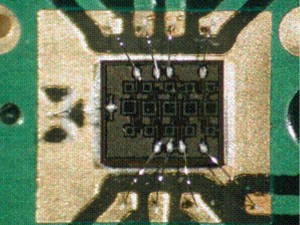My note: I just came across this site.
http://ncic.eng.uci.edu/
The Nanoscale Communication IC (NCIC) Lab carries out research on:
1. Silicon-based millimeter-wave/terahertz integrated circuits design for imaging, sensing, and wireless communications
2. CMOS integrated circuits for brain-computer interface (BCI) systems
The NCIC lab is equipped with state-of-the-art measurement instruments including high frequency vector network analyzer, spectrum analyzer, broadband analog signal source and probe station, as well as leading IC design softwares. The acquisition of the facility was made possible by a grant from the National Science Foundation under contract: CRI-0551735. The NCIC lab is actively involved in publishing research papers in leading IC design conferences and journals. The research in the NCIC lab has resulted in several U.S. patents.
Terahertz (THz) Integrated Circuits for Imaging, Sensing, and Communications
(Sponsors: NSF and JPL)
The vastly under-utilized spectrum in the THz frequency range enables disruptive applications including 10-gigabit chip-to-chip wireless communications and imaging/spectroscopy. On the imaging applications front, THz imaging is considered to be one of the emerging and disruptive technologies over the next decade [1]. As stated in that article: “great things are expected of terahertz waves in ranging from 0.3-3THz.” THz waves pass through non-conducting materials such as clothes, paper, wood and brick and so cameras sensitive to them can peer inside envelopes, into living rooms and “frisk” people at distance. THz imaging systems, therefore, will be key enabling components in applications such as security surveillance (to find concealed weapons and explosives), non-destructive testing, biology, radio astronomy, and medical imaging. On the sensing and communications, the absence of licensed frequency spectrum in the THz frequency range makes it possible to explore new unprecedented ideas on super-precise sensing at micrometer-level and multi-10-gigabit instant wireless access at the centimeter-level spacing between transmitter and receiver.
1. Zheng Wang, Pei-Yuan Chiang, Peyman Nazari, Chun-Cheng Wang, Zhiming Chen, and Payam Heydari, “A 210 GHz Fully Integrated Differential Transceiver with Fundamental Frequency VCO in 32 nm SOI CMOS,” IEEE Int’l Solid-State Circuits Conference (ISSCC), Feb. 2013.
2. Pei-Yuan Chiang, Omeed Momeni, and Payam Heydari, “A Highly Efficient 0.2 THz Varactor-Less VCO with -7dBm Output Power in 130nm BiCMOS,” IEEE Compound Semiconductor IC Symp. (CSICS), Oct. 2012.
3. Francis Caster, II, Leland Gilreath, Shiji Pan, Zheng Wang, Filippo Capolino, and Payam Heydari, “A 93-113GHz BiCMOS 9-Element Imaging Array Receiver Utilizing Spatial-Overlapping Pixels with Wideband Phase and Amplitude Control,” IEEE Int’l Solid-State Circuits Conference (ISSCC), Feb. 2013.
Terahertz (THz) IC Design


THz frequency range enables disruptive applications including 10-gigabit chip-to-chip wireless communications and imaging/spectroscopy.
Electro-Optic Phased-Array


Fully integrated passive/active imaging systems with on-chip antennas, while leveraging high level of integration offered by Silicon technologies.
Sub-Millimeter-Wave IC Design


The goal of this research is to design fully integrated transceivers for automotive radars and imaging systems.

No comments:
Post a Comment